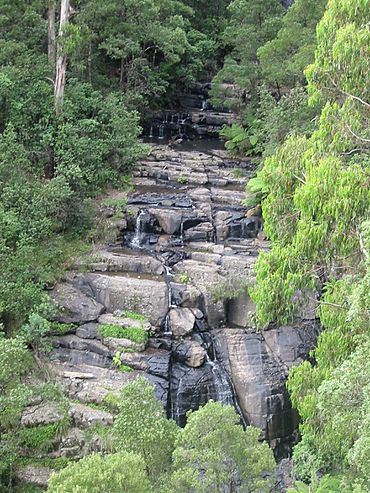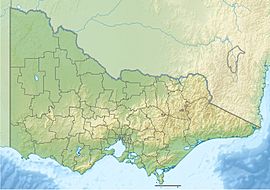Kinglake National Park facts for kids
Quick facts for kids Kinglake National ParkVictoria |
|
|---|---|
|
IUCN Category II (National Park)
|
|

Masons Falls in the Kinglake National Park
|
|
| Nearest town or city | Kinglake |
| Established | 7 March 1928 |
| Area | 232.1 km2 (89.6 sq mi) |
| Managing authorities | Parks Victoria |
| Website | Kinglake National Park |
| See also | Protected areas of Victoria |
The Kinglake National Park is a special natural area in central Victoria, Australia. It is about 50 kilometers (31 miles) northeast of Melbourne. This large park covers 23,210 hectares (about 57,350 acres). It is a great place to explore, with many walking tracks. Some tracks are even suitable for wheelchairs. You can also find places to camp here.
Contents
Discover Kinglake National Park
Kinglake National Park offers many exciting things to see and do. It is a wonderful place to connect with nature.
Masons Falls and Ancient History
One beautiful spot in the park is Masons Falls. It is a lovely picnic area with waterfalls and unique plants. The valley here is made of layered sediment. These layers are like old dirt and sand that settled long ago. They even contain fossils! This shows that the area was once covered by the sea.
Amazing Animals of the Park
You can spot many native Australian animals in Kinglake National Park. Look out for wallabies, kangaroos, wombats, possums, and echidnas. These animals live freely throughout the park.
Beautiful Birds of Kinglake
The park is also home to many kinds of birds. Keep an eye out for sulphur-crested cockatoos. You might also see black and red-headed cockatoos. Other colorful birds include Australian king parrots and rosellas. The amazing lyrebird, known for its mimicry, also lives here.
Victoria's Tallest Tree
Before the big bushfires in 2009, the park was famous for having the tallest tree in Victoria. This giant tree was a mountain ash, also known as Eucalyptus regnans. In 2002, it stood an incredible 91.6 meters (300 feet) tall. People believed it grew after the 1851 Black Thursday bushfires. It was located in the Wallaby Creek area of the park.
History of Kinglake National Park
The area around Kinglake National Park has an interesting past. It has seen changes from logging to major bushfires.
Early Logging in the Area
In the early 1900s, parts of this area were used for logging. This means trees were cut down for timber. You can still see some signs of this history today. Look for scars on some old trees. There is also a sawdust dump, which is a leftover from the logging days.
Bushfires and Recovery
Kinglake National Park has faced challenges from bushfires. In January 2006, a lightning strike started a fire. This fire burned parts of the park north of Kinglake township. It came very close to the town. Luckily, more thunderstorms and brave volunteers helped save the town.
In 2009, a very serious event happened. The devastating Black Saturday bushfires severely burned 98% of the national park. Much of the nearby town of Kinglake was also destroyed. Since then, a lot of hard work has gone into helping the park recover. Sections of the park are slowly being reopened for visitors. This shows how nature can heal and regrow after big events.


